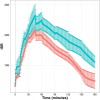Insulin Sensitivity and Insulin Secretion in Adults With Friedreich's Ataxia: The Role of Skeletal Muscle
- PMID: 39109797
- PMCID: PMC11747682
- DOI: 10.1210/clinem/dgae545
Insulin Sensitivity and Insulin Secretion in Adults With Friedreich's Ataxia: The Role of Skeletal Muscle
Abstract
Introduction: Friedreich's ataxia (FRDA) is a multisystem disorder caused by frataxin deficiency. FRDA-related diabetes mellitus (DM) is common. Frataxin supports skeletal muscle mitochondrial oxidative phosphorylation (OXPHOS) capacity, a mediator of insulin sensitivity. Our objective was to test the association between skeletal muscle health and insulin sensitivity and secretion in adults with FRDA without DM.
Methods: Case-control study (NCT02920671). Glucose and insulin metabolism (stable-isotope oral glucose tolerance tests), body composition (dual-energy x-ray absorptiometry), physical activity (self-report), and skeletal muscle OXPHOS capacity (creatine chemical exchange saturation transfer magnetic resonance imaging) were assessed.
Results: Participants included 11 individuals with FRDA (4 female), median age 27 years (interquartile range 23, 39), body mass index 26.9 kg/m2 (24.1, 29.4), and 24 controls (11 female), 29 years (26, 39), 24.4 kg/m2 (21.8, 27.0). Fasting glucose was higher in FRDA [91 vs 83 mg/dL (5.0 vs 4.6 mmol/L), P < .05]. Individuals with FRDA had lower insulin sensitivity (whole-body insulin sensitivity index 2.8 vs 5.3, P < .01), higher postprandial insulin secretion (insulin secretory rate incremental area under the curve 30-180 minutes, 24 652 vs 17,858, P < .05), and more suppressed postprandial endogenous glucose production (-.9% vs 26.9% of fasting endogenous glucose production, P < .05). In regression analyses, lower OXPHOS and inactivity explained some of the difference in insulin sensitivity. More visceral fat contributed to lower insulin sensitivity independent of FRDA. Insulin secretion accounting for sensitivity (disposition index) was not different.
Conclusion: Lower mitochondrial OXPHOS capacity, inactivity, and visceral adiposity contribute to lower insulin sensitivity in FRDA. Higher insulin secretion appears compensatory and, when inadequate, could herald DM. Further studies are needed to determine if muscle- or adipose-focused interventions could delay FRDA-related DM.
Keywords: Friedreich's ataxia; insulin secretion; insulin sensitivity; mitochondria; physical activity; skeletal muscle.
© The Author(s) 2024. Published by Oxford University Press on behalf of the Endocrine Society.
Figures










References
Publication types
MeSH terms
Substances
Grants and funding
- UL1TR000003/TR/NCATS NIH HHS/United States
- F32 DK128970/DK/NIDDK NIH HHS/United States
- Non-NIH
- UL1 TR001878/TR/NCATS NIH HHS/United States
- CHOP/Penn CHPS
- P30 DK19525/Penn Diabetes Research Center Radioimmunoassay and Biomarkers Core
- K23 DK102659/DK/NIDDK NIH HHS/United States
- UL1 TR000003/TR/NCATS NIH HHS/United States
- CHOP Friedreich's Ataxia Center of Excellence
- R01 HL149722/HL/NHLBI NIH HHS/United States
- P30 DK019525/DK/NIDDK NIH HHS/United States
- P41 EB029460/EB/NIBIB NIH HHS/United States
- P50 HD105354/HD/NICHD NIH HHS/United States
- K23DK102659/National Institutes of Health (NIH)
- UL1 TR001873/TR/NCATS NIH HHS/United States
LinkOut - more resources
Full Text Sources
Medical

